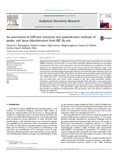JavaScript is disabled for your browser. Some features of this site may not work without it.
| dc.contributor.author | Balampanis, Dimitris E. | |
| dc.contributor.author | Coulon, Frederic | |
| dc.contributor.author | Simms, Nigel | |
| dc.contributor.author | Longhurst, Philip J. | |
| dc.contributor.author | Pollard, Simon J. T. | |
| dc.contributor.author | Fenech, Cecilia | |
| dc.contributor.author | Villa, Raffaella | |
| dc.date.accessioned | 2017-04-07T09:19:09Z | |
| dc.date.available | 2017-04-07T09:19:09Z | |
| dc.date.issued | 2017-01-26 | |
| dc.identifier.citation | Dimitris E. Balampanis, Frédéric Coulon, Nigel Simms, Philip Longhurst, Simon J.T. Pollard, Cecilia Fenech, Raffaella Villa, An assessment of different extraction and quantification methods of penta- and hexa-chlorobenzene from SRF fly-ash, Analytical Chemistry Research, Volume 12, June 2017, Pages 28-33 | en_UK |
| dc.identifier.issn | 2214-1812 | |
| dc.identifier.uri | http://doi.org/10.1016/j.ancr.2017.01.003 | |
| dc.identifier.uri | http://dspace.lib.cranfield.ac.uk/handle/1826/11753 | |
| dc.description.abstract | Highly chlorinated benzenes, produced in the presence of organic matter and chlorine, are considered PCDD/Fs precursors, and are used as cost and time convenient substitute indicators for the indirect measurement of the latter. In this study penta- and hexa-chlorobenzene are quantified for the determination of the organochloride load of fly ash from solid recovered fuel incineration. Some of the chlorobenzenes are formed under ‘de novo’ conditions, through heterogeneous (ash particles/flue gases) reactions and are therefore deeply incorporated within fly ash. Accelerated solvent extraction (ASE) and ultrasonic solvent extraction (USE), along with the equivalent clean-up methods suggested by literature were compared to traditional Soxhlet. The extraction efficiencies achieved were 83 ± 7.5% for Soxhlet, 111 ± 19% for PFE, and 67 ± 17% for ultrasonication. Soxhlet extraction and clean-up through a multilayer silica gel column gave more precise results compared to the other sample preparation methods. Furthermore, performance comparison of gas chromatography fitted with either a mass spectrometer operated in single ion monitoring mode (GC-MS-SIM), or electron capture detector (GC- ECD) highlighted that ECD can be used for measuring chlorobenzenes traces down to 0.21 ng g−1, when the equivalent LOQ for MS-SIM was 3.26 ng g−1. The results further suggest that ECD can provide better peak integration than MS-SIM in the detection of chlorobenzenes in fly ash extracts, due to the detector's sensitivity to halogenated compounds. | en_UK |
| dc.language.iso | en | en_UK |
| dc.publisher | Elsevier | en_UK |
| dc.rights | Attribution-Non-Commercial-No Derivatives 4.0 Unported (CC BY-NC-ND 4.0). You are free to: Share — copy and redistribute the material in any medium or format. The licensor cannot revoke these freedoms as long as you follow the license terms. Under the following terms: Attribution — You must give appropriate credit, provide a link to the license, and indicate if changes were made. You may do so in any reasonable manner, but not in any way that suggests the licensor endorses you or your use. Information: Non-Commercial — You may not use the material for commercial purposes. No Derivatives — If you remix, transform, or build upon the material, you may not distribute the modified material. No additional restrictions — You may not apply legal terms or technological measures that legally restrict others from doing anything the license permits. | |
| dc.subject | Organic halogens | en_UK |
| dc.subject | Solvent extraction | en_UK |
| dc.subject | Energy from waste | en_UK |
| dc.subject | SRF | en_UK |
| dc.subject | MBT | en_UK |
| dc.title | An assessment of different extraction and quantification methods of penta- and hexa-chlorobenzene from SRF fly-ash | en_UK |
| dc.type | Article | en_UK |
Files in this item
This item appears in the following Collection(s)
-
Staff publications (SWEE) [2825]
